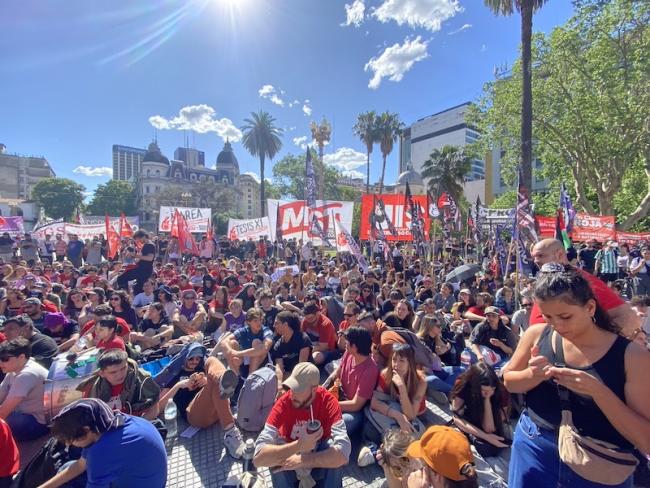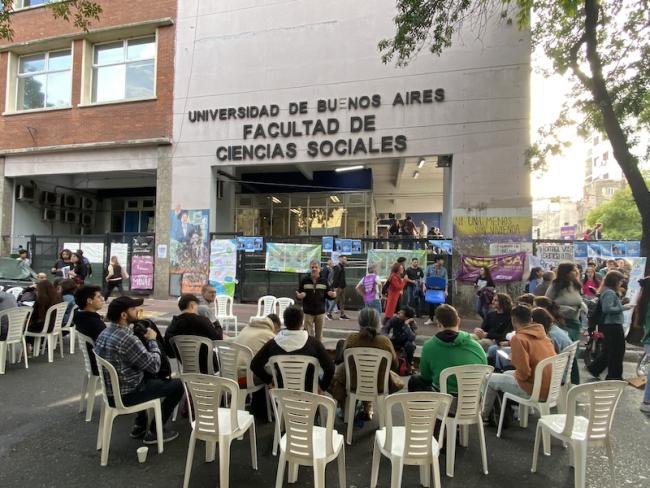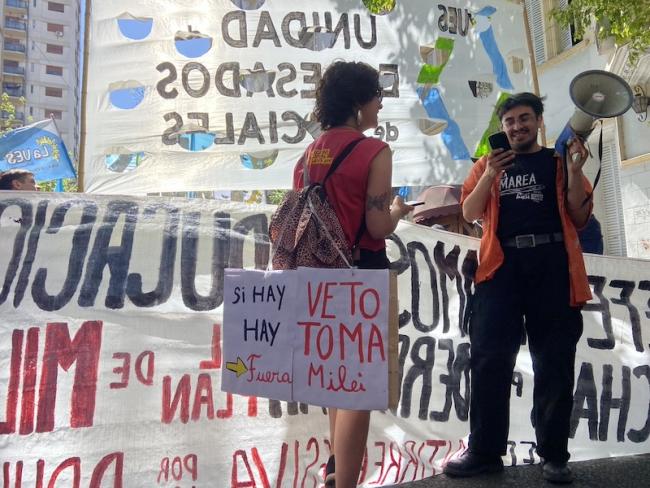
As the morning sun shines through the windows of the University of Buenos Aires’ Faculty of Social Sciences (FSOC) on October 9, students sit up from makeshift cardboard mattresses. No lectures will be held in these classrooms; instead, they serve as the meeting rooms and sleeping quarters for students who are occupying the faculty in defense of public universities. Outside, others carry desks and benches into the street, where students have blocked traffic to hold open-air classes. It’s been six years since FSOC was last taken, but only a few students in today’s occupation are old enough to have been there.
“It’s my first occupation,” says Josue Vega, a communications student from Bolivia. Vega has been involved in assemblies and marches since the beginning of the year, but he says this is the first time the student response has been “appropriate for the attack that public education is suffering.”

On October 2, Argentine President Javier Milei vetoed a university financing bill that would have adjusted national university budgets every two months based on changes in the consumer price index, peso exchange rate, and the cost of public services. The goal of the law was to guarantee funding for public universities’ operating costs and dignified wages for employees, as the Argentine Federation of National University claims professors’ wages have lost roughly two-thirds of their purchasing power since the president took office. The stated rationale for Milei’s veto is his “zero deficit” plan, which seeks to restore Argentina’s fiscal balance by cutting public spending, eliminating taxes—which he claims are a “remnant of slavery,” and reducing the scope of the federal government.
“From the beginning, [Milei] decided to put university students, and especially the social sciences, as enemy number one,” said Lucas Grimson, a senator in the FSOC governing council and a member of the faculty’s recently elected Student Center, a union organization in charge of advocating for the student body’s interests. “And that woke the sleeping giant that is the student movement.”
In response to the veto, which crystallized months of attacks on constitutional right to education in Argentina, students at over 30 universities across the country voted in open assemblies to occupy their campuses, some indefinitely. Such actions meant that students took over duties related to campus security, cleaning, and, most importantly, upper management. Decisions about the university were taken by the students themselves in assemblies.
The FSOC Student Center unilaterally lifted the faculty’s occupation on October 28, though occupations in other universities across the country continue. Nearly one year into Milei’s far-right libertarian government, the occupations embodied a symbolic and strategic escalation of resistance against not only Milei, but also Congress and university administrators, who many students say are complicit in putting universities on the chopping block in the country’s orthodox economic makeover.
The Movement in Context
Milei’s administration is not the first to defund higher education. In the 1990s, the Higher Education Law became a flashpoint for student struggles, part of a World Bank-backed reform that opened the door to tuition hikes and greater restrictions on enrollment.
“Many of us who are professors today were formed under the student struggles of the ‘90s,” says Juan Wahren, who began his undergraduate degree at the University of Buenos Aires in 1995. Today, he’s a professor of rural social movements and popular education in the FSOC.
A few months ago, Wahren and his fellow professors saw today’s student movement as a shadow of its former self. Recently, however, the perception has flipped. “I see lots of activity,” he says over the noise of students crowding around for the assembly where, two hours later, students unanimously voted to occupy the faculty. “Something got reactivated.”

A handful of student leaders in the FSOC today were also involved in the occupations of 2018, when students occupied 52 of Argentina’s 60 national public universities in response to former president Mauricio Macri’s financing plan, which included widespread cuts across public sectors. Macri’s logic at the time was not so different from Milei’s. “Deficit zero is a challenge given the recession,” reads a 2018 blog post from the Center for Implementation of Public Policy for Equity and Growth, in defense of the former president. Then, the kicker: “But it’s the road to access IMF financing and avoid even greater cuts.”
Daian Dezorzi, an activist with the FSOC’s Socialist Workers Movement (MST), says the current administration is defunding higher education as a way of paying the country’s odious debt.
“The money [for university] is there,” he tells me. “The issue is that various governments haven’t prioritized public education; instead, they’ve prioritized a socioeconomic system where the wealth that the working sectors of Argentina produce is sent off to pay debt interest. The money is there, it’s a question of where it’s going.”
Bigger than the University
Despite similarities with past conflicts, the current education cuts are not a mere intensification of previous austerity. Milei’s attack on public sectors is far more comprehensive, and the social context is equally unprecedented: in the last six months, three million more Argentines have fallen into poverty. Over half of the country’s population cannot afford a monthly basket of basic goods. Particularly following escalated repression against retirees and the government’s attempt to close a public mental health hospital, the university movement has been fueled by the conviction that the fight for education is deeply intertwined with struggles for dignified wages, pensions, and basic public services.
“We have to understand that Milei’s attack is not against one sector in particular…but against the collection of historic demands that the Argentine working class has achieved over decades of struggle,” Dezorzi said. “The task in front of us is to converge with other sectors.”
The cross-cutting nature of social organization and resistance was at the forefront of an October 8 student assembly at FSOC. Speakers at the assembly included a representative from Hospital Bonaparte, where workers launched an occupation to resist the facility’s anticipated closure, and from Aerolineas Argentinas, a state airline that has laid off 1,500 workers while undergoing privatization.
In addition to constructing ties across different sectors, the student movement has found enormous support from the general public. On April 24 and again on October 2, over a million people took to the streets nationwide for a Federal March for Education—some of the largest demonstrations in Argentina’s 41 years of democracy.
Yet, thus far, the student movement has been unable to translate this crescendo of popular support into legislative change. Although Milei’s party only holds 42 of 247 seats in the lower house of Congress, the chamber fell 12 votes short of the two-thirds majority needed to overturn his veto of the university financing bill.
The Conflicts Within
Most center-left groups point to Milei’s support from traditional conservative parties in Congress, especially former president Macri’s Propuesta Republicana (PRO) and the Unión Cívica Radical (UCR), as the reason for the current legislative bottleneck. These parties’ alliance with the libertarians was solidified when Macri’s former security minister Patricia Bullrich of the PRO, who ran a vehement campaign against Milei in the first-round presidential election, was appointed as his minister of security.
To combat this alliance, the country’s center-left establishment is turning its sights to the 2025 congressional elections.
“If we couldn’t reject the president’s veto, it’s because we still don’t have enough lawmakers,” said Máximo Kirchner, a representative in the Chamber of Deputies with the Justicialist Party, the largest branch of Peronism. “An objective for 2025 across the country is to construct an electoral force… that has the necessary votes in Congress.”
This position has drawn the ire of leftist groups, who say the stakes of Milei’s policies are too urgent to wait for an electoral victory.
“Every day that passes with Milei in office, there are a million kids who don’t eat, there are retirees who can’t take their medication, unemployment rises, and multinational extractivists loot our territory,” says Agus Romero, a leader of the MST.
The United Leftist Workers’ Front, unlike center-left Peronist groups, has declared “zero confidence” in Congress. Their leaders point to the evident social discontent demonstrated by the national education marches, and their methods focus on stoking that discontent into unified direct action.
At an intercollegiate assembly on October 27—from which the Student Center was notably absent—FSOC students voted to take part in a flash mob inspired by the students at the National University of the Arts. The student organizers also voted to lead a student contingent at the November 2 Pride march, accompany retirees in a demonstration on November 6, continue the university occupations, and organize a third nationwide march in defense of universities on November 12.
“Far from waiting to see what a legislator or deputy does, the fundamental conclusion we have to take from the veto is understanding the terrain on which we confront the government: it’s mobilization, it’s the street, it’s spaces of democratic decision-making and assemblies from below,” Dezorzi says.
“A New Model for Our Country”
As I sit with Dezorzi in front of the FSOC, he laments that although professors have only achieved a meager raise since the beginning of October, a sense of normalcy has returned to the faculty. Since ending the faculty’s occupation, the Student Center appears to be further moderating the movement’s more radical factions by delaying assemblies to define the faculty’s plan of action.
For Dezorzi, the internal struggles within the FSOC’s occupation demonstrate that public universities have become fertile ground for the country’s traditional political parties to install themselves, serving to dilute the student movement’s more disruptive currents. The current vice chancellor of UBA is the ex-president of the country’s oldest political party, for instance, and three delegates who voted to uphold Milei’s veto are themselves professors at public universities.
On the other hand, the inseparability of national and university politics is what makes the student movement so potent.
“Our task is not just to think about a new university model, but a new model for our country,” says Dezorzi. “We have to be discussing other ways of producing, of debating politics, of land ownership. Because we’re not just students, we’re also workers. And we have to think: in service of what are we going to produce knowledge?”
Lucas Bricca is a writer, interpreter, and NACLA intern. He currently researches social movements and popular education in Buenos Aires, Argentina.

